Decor
Traditional Russian Decor Elements Explained

Were you aware that the Russian culture boasts a profound and varied heritage of decorative crafts? Ranging from elaborate textiles and needlework to detailed wooden sculptures, their distinct aesthetic has fascinated individuals for generations.
In this article, I will delve into the world of Russian decor, exploring iconic Matryoshka dolls, imperial porcelain, and grand palaces.
Join me on this journey as we uncover the beauty and craftsmanship that Russians used to adorn their homes and lives.
Key Takeaways
- Traditional Russian decorative styles incorporate intricate patterns and vibrant colors, influenced by traditional Russian decorative motifs and folk art.
- Iconic Russian Matryoshka dolls originated in late 19th-century Russia and became popular worldwide, painted with vibrant colors and intricate designs.
- Ornate fabrics and embroidery are significant in traditional Russian clothing, with richly embroidered traditional costumes and intricate patterns inspired by nature, folklore, and religious motifs.
- Intricate wood carvings serve as a visual representation of Russian culture’s history, beliefs, and traditions, showcasing the skill and craftsmanship of artisans.
Traditional Russian Decorative Styles
Traditional Russian decor styles incorporate intricate patterns and vibrant colors. These styles are heavily influenced by traditional Russian decorative motifs and folk art. The motifs commonly used in Russian decor include floral patterns, geometric shapes, and ornate designs. These motifs are often found on various decorative items such as furniture, textiles, and ceramics.
The use of bold and contrasting colors is a characteristic feature of traditional Russian decor, with red, blue, and gold being the most prevalent. The intricate patterns and vibrant colors in traditional Russian decor reflect the rich cultural heritage and artistic traditions of Russia.
Now, let’s delve into the iconic Russian Matryoshka dolls, which are an integral part of Russian decor.
Iconic Russian Matryoshka Dolls
You’ll love the iconic Russian Matryoshka dolls that are used as decorative pieces. These dolls have a rich history and carry deep symbolism.
Matryoshka dolls, also known as nesting dolls, are made of wood and consist of multiple dolls stacked inside each other, with the smallest doll being the innermost. They originated in the late 19th century in Russia and quickly became popular worldwide. The dolls are often painted with vibrant colors and intricate designs, depicting various themes such as traditional Russian folklore, nature, or historical figures.
Each doll represents a different stage of life or a different character, symbolizing the unity and interconnectedness of generations. The matryoshka doll is not only a charming decorative item but also a reflection of Russian culture and tradition.
Transitioning into the subsequent section about ‘ornate fabrics and embroidery’, the use of vibrant colors and intricate designs seen on the matryoshka dolls is reminiscent of the elaborate craftsmanship found in traditional Russian textiles and embroidery.
Ornate Fabrics and Embroidery
Transitioning into the subsequent section about ‘ornate fabrics and embroidery’, the vibrant colors and intricate designs on the matryoshka dolls remind us of the beautiful craftsmanship found in traditional Russian textiles and embroidery.
When it comes to traditional Russian clothing, ornate fabrics and embroidery play a significant role in showcasing the rich cultural heritage of Russia. The Russian textile industry has a long history of producing exquisite fabrics and intricate embroidery, known for their detailed designs and vibrant colors.
Some key aspects of traditional Russian textiles and embroidery include:
- Richly embroidered traditional costumes, such as sarafans and kokoshniks
- Intricate patterns inspired by nature, folklore, and religious motifs
- The use of luxurious fabrics like silk, velvet, and brocade
These ornate fabrics and embroidery techniques not only add beauty and elegance to traditional Russian clothing but also reflect the skill and creativity of Russian artisans.
Transitioning into the subsequent section about ‘intricate wood carvings,’ the artistry and attention to detail in Russian textiles and embroidery are mirrored in the intricate woodwork seen in Russian decor.
Intricate Wood Carvings
As I delve into the world of intricate wood carvings, I am struck by their profound cultural significance. These carvings serve as a visual representation of a culture’s history, beliefs, and traditions, often depicting important figures, symbols, and stories.
Traditional carving techniques, passed down through generations, showcase the skill and craftsmanship of the artisans who bring these wooden masterpieces to life. Each region and culture has its own unique carved designs, characterized by intricate details, symbolic motifs, and distinct artistic styles, making them truly one-of-a-kind creations.
Cultural Significance of Carvings
If you visit Russia, you’ll notice that carvings hold significant cultural value. They are not just decorative pieces but have deep cultural interpretation and historical preservation significance. Here are three reasons why carvings are culturally significant in Russia:
-
Traditional symbolism: Carvings often depict symbols that hold cultural and historical significance. These symbols can represent various aspects of Russian culture, such as folklore, religious beliefs, or national identity.
-
Artistic expression: Carvings showcase the artistic skills of Russian artisans who carefully craft intricate designs and patterns. This art form has been passed down through generations, preserving traditional techniques and styles.
-
Historical preservation: Carvings serve as a visual representation of Russia’s rich history. They can be found in historical buildings, churches, and museums, preserving the cultural heritage and providing insights into the past.
Overall, carvings in Russia are more than just beautiful decorations; they are a means of cultural expression, historical preservation, and storytelling.
Traditional Carving Techniques
After exploring the cultural significance of carvings in Russian decor, it’s important to understand the traditional carving techniques that were utilized.
Traditional carving tools played a vital role in creating intricate designs on various surfaces. These tools included chisels, gouges, knives, and rasps. The craftsmen would carefully carve away layers of wood or stone to reveal beautiful patterns and shapes.
The techniques used in Russian carving were influenced by historical factors such as Byzantine art, Gothic architecture, and the ornate styles of the Baroque and Rococo periods. These influences can be seen in the intricate detailing and delicate motifs found in Russian carved decor.
With a deep understanding of the traditional carving techniques and historical influences, we can now delve into the unique carved designs that adorned Russian homes and buildings.
Unique Carved Designs
To truly appreciate the unique carved designs, take a closer look at the intricate patterns and delicate motifs found in Russian homes and buildings. These designs are a reflection of the rich cultural heritage of Russian folk art and the historical wooden architecture that has been passed down through generations.
Here are some key features of these unique carved designs:
-
Intricate floral patterns: Russian folk art is known for its beautiful floral motifs, often inspired by nature. These designs are meticulously carved into wooden panels, creating a stunning visual effect.
-
Symbolic motifs: Many of the carved designs in Russian architecture have symbolic meanings. For example, the sun symbolizes fertility and prosperity, while the tree of life represents the interconnectedness of all living beings.
-
Geometric patterns: Alongside the floral and symbolic motifs, geometric patterns also play a significant role in Russian carved designs. These patterns are often symmetrical and repetitive, adding a sense of harmony and balance to the overall design.
Imperial Russian Porcelain and Ceramics
Imperial Russian porcelain and ceramics were highly valued for their intricate designs and craftsmanship. These exquisite pieces were a symbol of luxury and prestige, often adorning the tables and cabinets of the Russian nobility.
The production of imperial porcelain began in the early 18th century, with the establishment of the Imperial Porcelain Factory in St. Petersburg. The factory produced a wide range of items, including dinnerware, vases, and figurines, all characterized by their meticulous attention to detail and high-quality materials.
Traditional ceramics, on the other hand, were crafted by skilled artisans using age-old techniques. These ceramics often featured hand-painted motifs inspired by Russian folk art and nature.
Both imperial porcelain and traditional ceramics played a significant role in Russian decorative arts, showcasing the country’s rich cultural heritage and artistic prowess.
Grand Russian Palaces and Architectural Marvels
The grand Russian palaces and architectural marvels are breathtaking examples of opulence and architectural brilliance. As I wander through these magnificent structures, the interiors never fail to captivate me with their ornate detailing and lavish decor. The famous Russian architects who crafted these spaces have left an indelible mark on the world of architecture.
Here are three sub-lists that highlight the key features of Russian palace interiors and the contributions of these renowned architects:
-
Intricate Ceiling Designs:
-
Elaborate frescoes and stuccowork adorn the ceilings, showcasing scenes from mythology and history.
-
Gold leaf accents and ornamental moldings add a sense of grandeur and opulence.
-
Crystal chandeliers illuminate these magnificent spaces, casting a dazzling glow on the intricate designs.
-
Richly Decorated Walls:
-
Gilded paneling and silk tapestries grace the walls, creating a regal atmosphere.
-
Exquisite paintings by renowned artists adorn the halls, depicting important historical events and portraits of the royal family.
-
Mirrors strategically placed to reflect the beauty of the surroundings and create an illusion of spaciousness.
-
Luxurious Furnishings:
-
Plush velvet upholstery and embroidered fabrics cover the furniture, exuding elegance and comfort.
-
Hand-carved wooden furniture, adorned with intricate detailing, adds a touch of sophistication.
-
Persian rugs and marble flooring complete the opulent ambiance, providing a luxurious underfoot experience.
These Russian palace interiors, designed by famous Russian architects, are a testament to the rich cultural heritage and artistic prowess of the country. They continue to inspire awe and admiration, showcasing the grandeur of the Russian imperial era.
Frequently Asked Questions
What Are Some Common Elements Found in Traditional Russian Decorative Styles?
In traditional Russian decorative styles, you will find elements inspired by Russian folk art and traditional Russian architecture. These include intricate wood carvings, vibrant colors, floral motifs, and ornate patterns.
How Are Matryoshka Dolls Made and What Is Their Significance in Russian Culture?
Matryoshka dolls, a symbol of Russian culture, hold great significance. Crafted using a variety of techniques and materials, these nesting dolls are not only decorative, but also represent the concept of family and the unity of generations.
What Are Some Popular Motifs and Patterns Used in Russian Fabrics and Embroidery?
Popular motifs in Russian fabrics and embroidery include floral patterns, geometric designs, and traditional Russian decorative styles. These motifs are commonly used to adorn clothing, home decor, and accessories, adding a touch of cultural heritage to the overall aesthetic.
How Is the Process of Creating Intricate Wood Carvings in Russia?
The process of creating intricate wood carvings in Russia involves various techniques such as chip carving and relief carving. These carvings are commonly used for decorative purposes and can be found in furniture, architectural elements, and religious icons.
What Are Some Notable Examples of Imperial Russian Porcelain and Ceramics and What Makes Them Unique?
Imperial Russian porcelain, such as the famous Fabergé eggs, and intricately painted ceramics are notable examples of Russian decor. Matryoshka dolls, with their nesting design, are also a unique and popular decorative item.
How Can Backlighting be Incorporated into Traditional Russian Decor?
Incorporating backlighting in decor concept to traditional Russian decor can add a modern touch. Install LED strips behind intricate wood carvings or ornate icons to create a warm, inviting glow. Use diffused lighting to highlight traditional textiles like matryoshka dolls or samovars, bringing attention to their intricate details.
How Can Traditional Russian Decor Elements be Incorporated into Tokyo Ghouls Decor?
Traditional Russian decor elements such as intricate wood carvings, ornate paintings, and vibrant textiles can be incorporated into Tokyo ghouls decor ideas to create a unique fusion of styles. Adding Matryoshka dolls, samovars, and folk art motifs can bring an intriguing juxtaposition to the overall design scheme.
How Are Traditional Russian Decor Elements Different from Traditional Italian and Spanish Decorations?
When comparing traditional Russian decor elements to traditional Italian and Spanish decorations, it’s apparent that each culture embraces unique styles. Russian decor often incorporates intricate patterns and bold colors, while traditional Italian and Spanish decorations ideas favor a mix of warm earth tones and ornate details.
Conclusion
In conclusion, it’s fascinating to discover the various decorative styles that Russians have used throughout history. From the iconic Matryoshka dolls to the intricate wood carvings and ornate fabrics, Russian decor is rich in tradition and artistry.
The use of Imperial Russian porcelain and ceramics adds a touch of elegance to any space. And let’s not forget the grand Russian palaces and architectural marvels that continue to awe and inspire.
Coincidentally, exploring Russian decor feels like stepping into a world of beauty and craftsmanship.
- About the Author
- Latest Posts
Introducing Charles, the Editor in Chief at ByRetreat, whose passion for interior design and editorial excellence elevates every remote workspace to new heights. With his keen eye for detail, impeccable taste, and expertise in design, Charles brings a wealth of knowledge and creativity to the ByRetreat team.
As the Editor in Chief of a renowned lifestyle blog, Charles has honed his skills in curating captivating content and staying up-to-date with the latest trends in interior design. His deep understanding of aesthetics and the power of storytelling through design enables him to create remote workspaces that are not only visually stunning but also rich in personality and meaning.
Mardi Gras Decoration
What Is the Theme of the Zulu Parade 2023?
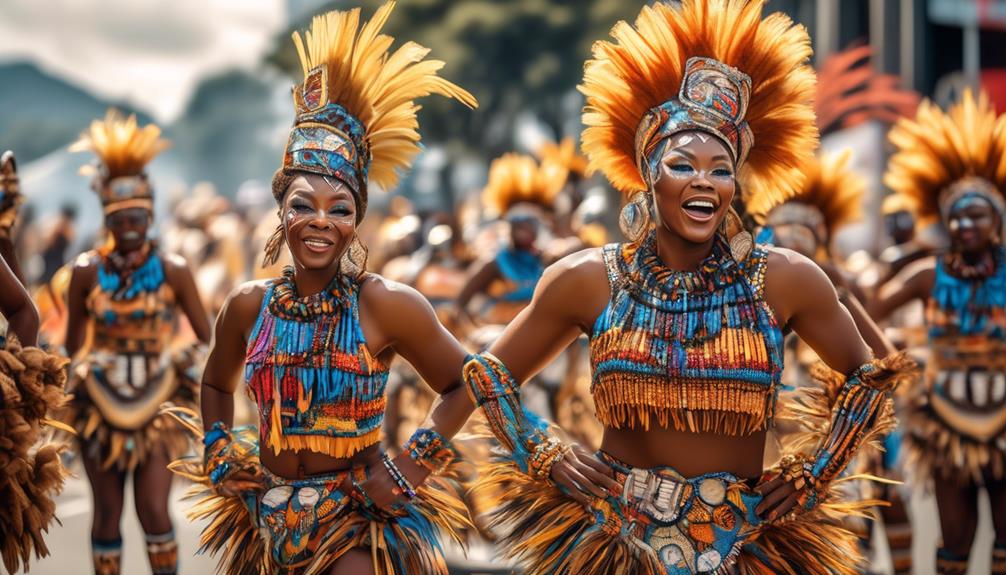
The Zulu Parade seamlessly blends tradition with modern relevance, creating an experience that resonates with attendees. Excitement is building as we eagerly anticipate the reveal of the 2023 theme.
The Zulu Parade has always been a vibrant celebration of culture and community, and this year's theme promises to be no different. Stay tuned as we explore the origins of the Zulu Parade, its evolution through the years, and the symbolism and cultural significance behind the chosen theme for 2023.
Key Takeaways
- The theme of the Zulu Parade 2023 is 'Embracing Diversity: Unity in Culture', celebrating diverse traditions, beliefs, and backgrounds and promoting inclusivity and understanding.
- The costumes and attire in the parade hold cultural significance and symbolism, reflecting the rich cultural heritage of the Zulu people and representing unity, beauty, strength, pride, and the spirit of the Zulu warriors.
- The parade represents the rich tapestry of traditions and customs within the Zulu community, showcasing unity, resilience, and a celebration of history and traditions.
- The Zulu Parade 2023 offers a visual splendor and profound impact on spectators, fostering a sense of community involvement, pride, and belonging, while also providing an opportunity for individuals from diverse backgrounds to come together and appreciate cultural diversity.
Origins of the Zulu Parade
The Zulu Parade traces its origins back to the early 20th century when a group of African American laborers and artisans in New Orleans came together to form a social and benevolent organization. Their aim was to create a sense of community and support within the African American population during a time of segregation and hardship.
From these humble beginnings, the Zulu Parade has evolved into a vibrant cultural celebration that showcases the rich heritage and traditions of the African American community in New Orleans.
The parade is steeped in traditional artistry, with elaborate floats, intricately designed costumes, and lively musical performances that pay homage to the cultural roots of the participants. Each aspect of the parade is a testament to the creativity and skill of the community members who pour their hearts into the event every year. It's truly a sight to behold as the streets come alive with the rhythmic beats of traditional music and the dazzling display of colorful costumes.
The Zulu Parade stands as a testament to the resilience and creativity of the African American community in New Orleans, and it continues to be a cherished and integral part of the city's cultural tapestry.
Evolution of Parade Themes

As we reflect on the evolution of parade themes, it's fascinating to see how historical themes have shaped the Zulu Parade over the years.
We can also look forward to the creative future themes that will continue to captivate and engage the community.
The progression of parade themes not only showcases the rich cultural heritage but also speaks to the innovative spirit of the Zulu Parade.
Historical Parade Themes
In the history of parade themes, the evolution of the Zulu Parade's themes reflects the changing cultural and social landscape of the community. Each theme holds cultural importance and historical significance, serving as a lens into the community's values and aspirations.
Over the years, the parade themes have mirrored the community's celebration of its rich heritage and traditions, as well as its response to contemporary issues and artistic expression. The historical parade themes have been a reflection of the community's collective identity and have provided a platform for artistic and cultural expression.
From honoring ancestral legacies to celebrating resilience and progress, these themes have woven a rich tapestry of the community's history and aspirations. As we look back at the parade's historical themes, we witness the dynamic and evolving nature of the Zulu Parade, encapsulating the spirit and essence of the community.
Creative Future Themes
Reflecting our community's dynamic spirit and evolving cultural landscape, the future themes of the Zulu Parade will continue to embody our rich heritage and serve as a platform for artistic and cultural expression. As we look towards the future, we envision themes that seamlessly blend tradition with future innovation, captivating the hearts and minds of both participants and spectators. Our aim is to draw artistic inspiration from our history while also embracing modern influences, creating themes that resonate with the diverse tapestry of our community. Here is a glimpse of what the creative future themes of the Zulu Parade may look like:
| Future Innovation | Artistic Inspiration | Cultural Fusion |
|---|---|---|
| Technological Advancements | Indigenous Art Forms | Global Collaborations |
Unveiling the 2023 Theme
With great anticipation and excitement, we're thrilled to reveal the highly anticipated theme for the Zulu Parade 2023. This year's theme is 'Embracing Diversity: Unity in Culture,' which captures the essence of our cultural celebration and the spirit of togetherness that defines the Zulu Parade. As we embark on this journey of celebration and unity, we aim to highlight the beauty of diversity and the unifying power of culture.
- Embracing Differences: Our theme encourages the celebration of diverse traditions, beliefs, and backgrounds, emphasizing the richness that diversity brings to our communities.
- Unity Through Culture: We seek to showcase how various cultural expressions can serve as a unifying force, fostering understanding, respect, and solidarity among different groups.
- Honoring Heritage: This theme invites us to honor and pay homage to the traditions and heritage of all cultures represented in the parade, recognizing their invaluable contributions to our society.
- Inspiring Inclusivity: By promoting inclusivity and understanding, we aspire to inspire a sense of belonging and acceptance, creating a space where everyone feels valued and respected.
We are eager to witness the vibrant displays and performances that will bring our theme to life, uniting us in a joyous celebration of diversity and culture.
Symbolism and Cultural Significance

As we explore the 2023 Zulu Parade theme, it's important to consider the symbolic costume details and their cultural significance.
This year's theme not only showcases the vibrant traditions of the Zulu people but also serves as a representation of their rich cultural heritage.
Our examination will shed light on the deeper meanings behind the costumes and how they contribute to the overall cultural significance of the parade.
Symbolic Costume Details
The costumes worn during the Zulu Parade 2023 are infused with rich symbolism and cultural significance, reflecting the heritage and traditions of the Zulu people. Each detail of the attire is a deliberate artistic expression, carrying deep cultural symbolism.
- Beadwork: Intricately designed beadwork adorns the costumes, symbolizing unity and beauty within the community.
- Animal Prints: Animal prints are incorporated into the costumes, representing the Zulu people's connection to nature and their respect for wildlife.
- Feathered Headdresses: Elaborate feathered headdresses are worn, symbolizing strength, pride, and the spirit of the Zulu warriors.
- Color Symbolism: The vibrant colors used in the costumes hold specific meanings, with red symbolizing passion and vitality, while black represents the people's roots and unity.
These costume details aren't merely decorative; they're a profound reflection of the Zulu culture, history, and values.
Cultural Heritage Representation
Our exploration of the Cultural Heritage Representation (Symbolism and Cultural Significance) unveils the profound layers of meaning embedded within the Zulu Parade 2023.
The representation of cultural diversity in the parade is a testament to the rich tapestry of traditions and customs within the Zulu community. Each element of the parade, from the vibrant costumes to the rhythmic music, serves as a powerful symbol of the diverse cultural heritage cherished by the Zulu people.
The parade proudly showcases the unity and resilience of the community, celebrating its history and traditions while embracing the present and looking toward the future. Through this representation, the Zulu Parade 2023 not only entertains and captivates but also educates and enlightens, offering a window into the cultural soul of the Zulu people.
Parade Elements and Interpretation
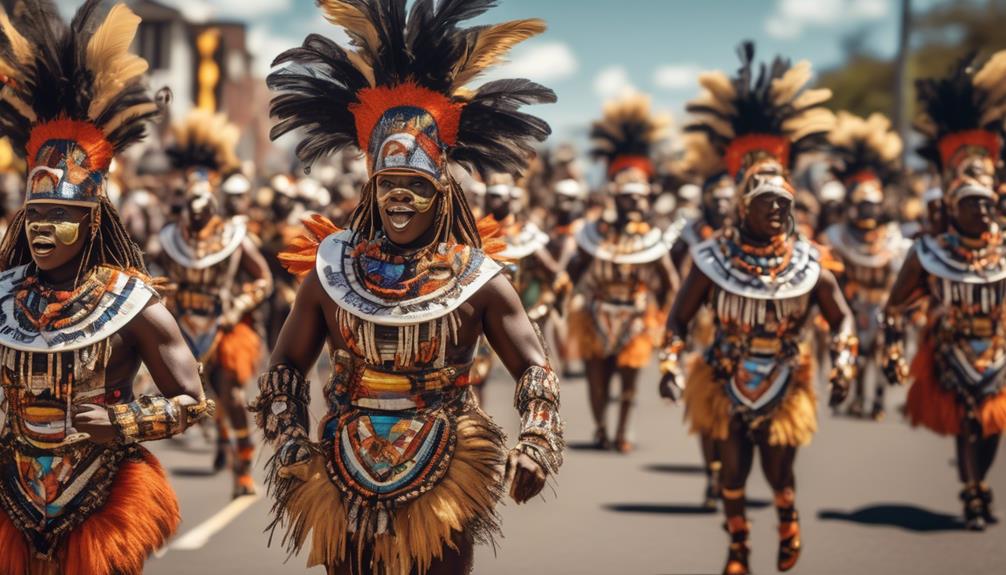
Exploring the vibrant and symbolic elements of the Zulu Parade offers a rich opportunity to understand the cultural significance and interpretation behind each aspect of this celebrated event. The parade elements and their interpretations are deeply rooted in the rich traditions and history of the Zulu culture. Each component contributes to the overall narrative and spectacle of the parade, offering an immersive experience for both participants and spectators.
- Parade Floats: The intricately designed and meticulously crafted floats serve as visual representations of Zulu folklore, historical events, and cultural icons. They convey stories and messages that are central to the Zulu community, showcasing the artistry and creativity of the parade participants.
- Traditional Dances: The rhythmic and energetic traditional dances performed during the parade are more than just captivating spectacles. They're expressions of cultural identity and pride, with each movement and gesture carrying profound meanings that reflect the values and beliefs of the Zulu people.
- Costumes and Attire: The attire worn by parade participants is steeped in symbolism, with vibrant colors, patterns, and accessories conveying messages about heritage, status, and spirituality.
- Music and Chants: The melodic tunes and powerful chants that accompany the parade serve as aural expressions of Zulu traditions, evoking a sense of unity and celebration among participants and onlookers alike.
Anticipated Impact on Spectators

As we immerse ourselves in the vibrant and symbolic elements of the Zulu Parade, one can't help but anticipate the profound impact it will have on spectators, weaving together a tapestry of cultural significance and visual splendor.
The anticipated impact on spectators is palpable, with the parade serving as a catalyst for fostering a sense of community involvement and pride. As the floats adorned with intricate designs and vibrant colors make their way through the streets, spectators will experience a deep connection to the rich heritage and traditions of the Zulu culture. The rhythmic beats of the drumming and the energetic dance performances will ignite a sense of unity and celebration among the onlookers, creating an atmosphere of joy and togetherness.
The parade's anticipated impact on spectators extends beyond mere entertainment; it provides an opportunity for individuals from diverse backgrounds to come together and revel in the shared experience. Witnessing the creativity and dedication of the parade participants will undoubtedly leave a lasting impression, inspiring a renewed appreciation for cultural diversity and the power of collective celebration.
The Zulu Parade 2023 is poised to leave an indelible mark on spectators, fostering a sense of connection and belonging within the community.
Frequently Asked Questions
How Are Parade Themes Chosen Each Year for the Zulu Parade?
When we consider the selection process for parade themes, community involvement plays a crucial role. The theme is often chosen through a collaborative effort that reflects the values and interests of the community.
This process ensures that the chosen theme resonates with the diverse perspectives and experiences within the Zulu Parade community. Community involvement fosters a sense of unity and inclusivity, making the theme selection an inclusive and representative effort.
Are There Any Special Traditions or Rituals Associated With the Unveiling of the Parade Theme?
Special ceremonies and unveiling rituals are a significant part of the Zulu Parade. Traditional attire adds to the cultural significance.
The theme announcement is a moment of great anticipation and pride. The community gathers, eagerly awaiting the revelation. The unveiling of the parade theme is a cherished tradition, steeped in history and symbolism.
It's a deeply meaningful experience, connecting us to our heritage and celebrating our identity.
What Specific Symbols or Cultural References Can Spectators Expect to See in the 2023 Parade Theme?
In the Zulu Parade 2023, spectators can expect to see an array of cultural symbolism and traditional references that honor our rich heritage. The theme will highlight iconic symbols and historical references that hold deep significance within our community.
As we celebrate our cultural identity, spectators will witness vibrant displays that pay homage to our traditions, bringing to life the essence of our heritage through the parade's theme.
Are There Any New Elements or Surprises That Organizers Have Planned for the 2023 Zulu Parade?
We've been working hard to bring new floats and performance surprises to the 2023 Zulu Parade. The excitement is building as we prepare to unveil these elements, creating an experience that will captivate and delight spectators.
Our team is dedicated to infusing the parade with fresh energy and creativity, ensuring that everyone can look forward to an unforgettable celebration.
Get ready to be amazed by what we've in store!
How Do Organizers Anticipate the 2023 Parade Theme Will Impact the Community and Spectators in Particular?
Anticipating the 2023 parade theme's impact on the community and spectator engagement, we're excited to see how it will bring people together, celebrate diversity, and showcase creativity.
The theme's influence on the community will foster unity and pride, while engaging spectators with vibrant displays and meaningful storytelling.
We're optimistic that this theme will create a memorable and inclusive experience, deepening the parade's connection with the community and leaving a lasting impression on spectators.
Conclusion
As we bid farewell to the Zulu Parade 2023, we find ourselves swept away by the vibrant theme that brought the streets to life. Like a river flowing through the heart of our community, the parade's theme carried with it the spirit of unity and celebration.
As we look back on the joyous festivities, we're reminded that the theme not only adorned the floats, but also our hearts, leaving an everlasting mark on our souls.
- About the Author
- Latest Posts
Introducing Ron, the home decor aficionado at ByRetreat, whose passion for creating beautiful and inviting spaces is at the heart of his work. With his deep knowledge of home decor and his innate sense of style, Ron brings a wealth of expertise and a keen eye for detail to the ByRetreat team.
Ron’s love for home decor goes beyond aesthetics; he understands that our surroundings play a significant role in our overall well-being and productivity. With this in mind, Ron is dedicated to transforming remote workspaces into havens of comfort, functionality, and beauty.
Mardi Gras Decoration
How Do You Store Inflatable Lawn Decorations?

It is a common tradition for many households in the United States to decorate their lawns with festive inflatables, with over 70% of households participating in this practice to bring some holiday spirit to their outdoor areas.
But once the holiday season is over, the question arises: how do we store these larger-than-life decorations? It's not just about deflating and tossing them into the garage. There are specific techniques and storage solutions that can help preserve the lifespan and appearance of these beloved lawn ornaments.
So, what's the best way to ensure their longevity and keep them in pristine condition for the next celebration?
Key Takeaways
- Deflate and clean the inflatable decorations properly before storing.
- Use a large plastic storage bin and label it for easy identification.
- Protect the decorations from extreme temperatures and moisture damage by storing them in airtight containers.
- Consider utilizing hanging storage solutions or a storage shed for efficient organization and protection.
Deflate the Inflatables Carefully
How can we ensure that we deflate the inflatables carefully to avoid any damage or wear?
It's important to handle our beloved inflatables with the utmost care, especially when it comes to deflating them for storage.
To begin with, make sure to clean the inflatables properly before deflating them. This will help prevent any dirt or debris from causing damage during storage.
Once clean, carefully deflate the inflatables, ensuring that all the air is removed. Gently press on the inflatable to push out the air, being mindful not to apply too much force that could cause creases or folds.
When it comes to storing these inflatable decorations, a storage shed can be an ideal solution. It provides a cool, dry, and protected environment that can help prolong the life of the inflatables.
Another option is to utilize hanging solutions within the storage shed to keep the inflatables off the ground and prevent any unnecessary pressure or strain on the material.
Clean and Dry the Decorations

After carefully deflating the inflatables and ensuring all the air is removed, the next step is to clean and thoroughly dry the decorations. This is crucial for maintaining their quality and preventing damage during storage. Here's how we go about it:
- Gentle Cleaning: Use a mild soap and water solution to gently clean the decorations. Avoid harsh chemicals or abrasive scrubbing, as these can damage the material.
- Rinse and Air Dry: After cleaning, thoroughly rinse the decorations to remove any soap residue. Then, allow them to air dry completely before attempting to store them.
- Avoid Sunlight: When drying the inflatables, it's important to avoid direct sunlight, as prolonged exposure can cause fading and damage to the material.
- Inspect for Moisture: Before storing, ensure that the decorations are completely dry, inside and out. Any moisture left inside could lead to mold and mildew growth.
Use a Large Plastic Storage Bin
We prefer storing our inflatable lawn decorations in a large plastic storage bin to keep them organized and protected from potential damage. This method ensures that our decorations remain in excellent condition and are easy to locate when we're ready to use them again. The storage organization provided by the bin also saves us time when it comes to setting up our yard for different occasions or seasons.
Additionally, the weather protection offered by the plastic bin is crucial in safeguarding our decorations from moisture, sunlight, and other outdoor elements that could cause deterioration.
Using a large plastic storage bin for our inflatable lawn decorations has been a game-changer. It not only keeps everything tidy and easy to access but also shields our beloved decorations from the unpredictable weather. When it's time to decorate our yard, we can simply open the bin and find our decorations looking as good as new. The peace of mind that comes with knowing our decorations are safe and well-preserved is truly invaluable.
Roll the Deflated Decorations

Rolling the deflated decorations is an efficient way to store them compactly and prevent unnecessary creases or folds. Proper storage techniques are essential for maintaining the quality of your inflatable lawn decorations.
Here are some tips for rolling deflated decorations to prevent damage:
- Start with a Clean Surface: Lay the deflated decoration on a clean and flat surface to begin the rolling process. This ensures that no dirt or debris get trapped inside the decoration during storage.
- Smooth Out Any Wrinkles: Gently smooth out any wrinkles or folds in the decoration before rolling it up. This helps to prevent creases from forming and causing damage over time.
- Roll Tightly and Securely: Roll the decoration tightly from one end to the other, pressing out any excess air as you go. This compact rolling method prevents unnecessary strain on the material.
- Use a Storage Strap or Bag: Once rolled, use a storage strap or bag to secure the rolled decoration. This helps to maintain its shape and prevents it from unraveling during storage.
Label the Storage Containers
We've found that having a clear labeling system for our inflatable lawn decorations has made it so much easier to store and retrieve them.
With a quick identification method in place, we can easily locate the decorations we need without rummaging through all the storage containers.
It's truly been an organized storage solution that has saved us time and hassle.
Clear Labeling System
To maintain organization and ease of access, it's essential to implement a clear labeling system on the storage containers for inflatable lawn decorations. Here's how we can achieve an efficient labeling system:
- Consistent Format: Use a consistent format for labeling all containers, such as labeling by holiday or type of decoration.
- Clear and Visible: Ensure that labels are clear and visible from a distance to easily identify the contents.
- Color Coding: Consider using color-coded labels to differentiate between different holidays or types of decorations.
- Inventory List: Maintain an inventory list that corresponds to the labels on the containers to keep track of all decorations.
Quick Identification Method
Implementing a quick identification method through clear and distinct labeling on the storage containers facilitates efficient organization of inflatable lawn decorations.
By using identification tags, such as colorful labels or tags with clear descriptions, we can easily identify the contents of each container.
When storing inflatable lawn decorations, it's essential to label the storage location on each container to make it easier to locate specific items.
This quick identification method not only saves time but also reduces the frustration of searching through numerous containers.
Additionally, it allows for seamless retrieval and placement of the decorations when needed.
Clear and concise labeling ensures that everyone involved in the storage and retrieval process can easily identify the contents and storage location, making the entire process more manageable.
Organized Storage Solution
To achieve an organized storage solution for inflatable lawn decorations, we can start by labeling the storage containers with clear and descriptive tags. This simple step can make a significant difference in the storage organization process and ensure easy access to specific decorations when needed. Here's how we can go about it:
- Label by Theme: Categorize the inflatables by themes such as holidays, seasons, or specific events.
- Include Descriptions: Write brief descriptions on the tags to easily identify the contents of each container.
- Prioritize Usage: Label containers based on the frequency of use to ensure the most accessible decorations are readily available.
- Maintenance Notes: Consider adding tags with inflatable maintenance instructions to ensure proper care and longevity.
Store in a Cool, Dry Place
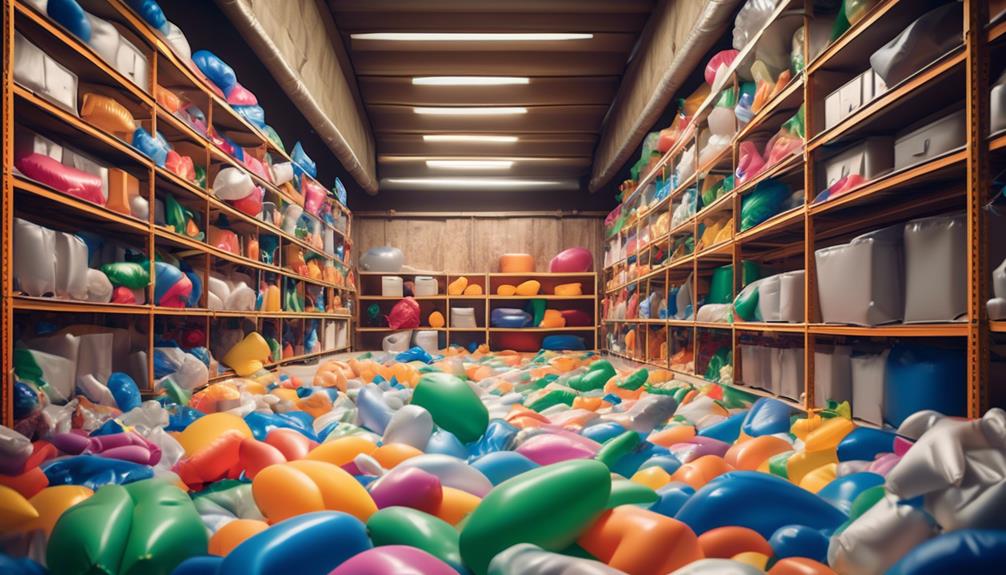
We recommend storing inflatable lawn decorations in a cool, dry place to ensure their longevity and prevent damage. Cool storage and dry preservation are crucial for keeping your inflatables in top condition. When the decorations aren't in use, finding a suitable spot in the garage or a storage closet can help protect them from excessive heat, moisture, and potential mildew growth.
Our own experience has taught us that storing inflatables in a cool, dry place can significantly extend their lifespan, saving you money in the long run. Additionally, it's essential to keep them away from direct sunlight, as prolonged exposure can cause the colors to fade and the material to deteriorate.
By taking these simple steps, we've found that our inflatables stay in excellent shape and are ready to delight us year after year.
Avoid Sharp Objects
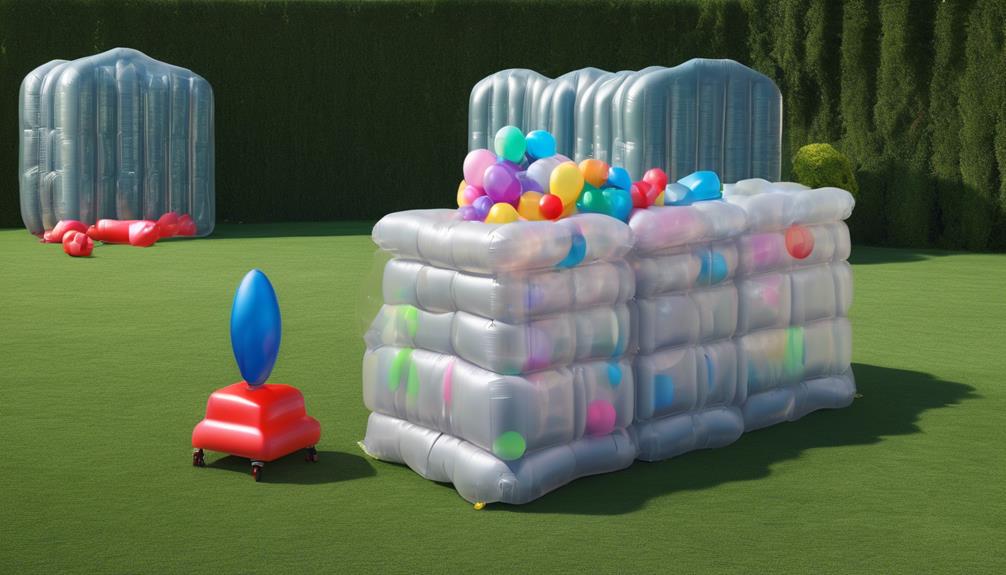
After safeguarding our inflatable lawn decorations in a cool, dry place, it's important to be mindful of avoiding sharp objects that could puncture or damage them. Here are some tips for protecting your inflatable lawn decorations:
- Avoid overinflating: Overinflating your decorations can make them more susceptible to damage from sharp objects. Be sure to follow the manufacturer's guidelines for proper inflation levels to ensure durability.
- Proper storage techniques: When storing your inflatables, make sure they aren't in contact with any sharp items such as gardening tools, metal furniture, or sharp edges of other decorations. It's best to place them in a dedicated storage bin or container to prevent accidental punctures.
- Regularly inspect the storage area: Check the storage area for any potential hazards that could damage your inflatables. Look for sharp edges, nails, or any other objects that could cause harm.
- Use protective barriers: If possible, create a barrier around your inflatable decorations to prevent accidental damage. This could be as simple as placing them in an area of the yard that's less frequented or using temporary fencing to create a protective perimeter.
Consider Using Vacuum Storage Bags
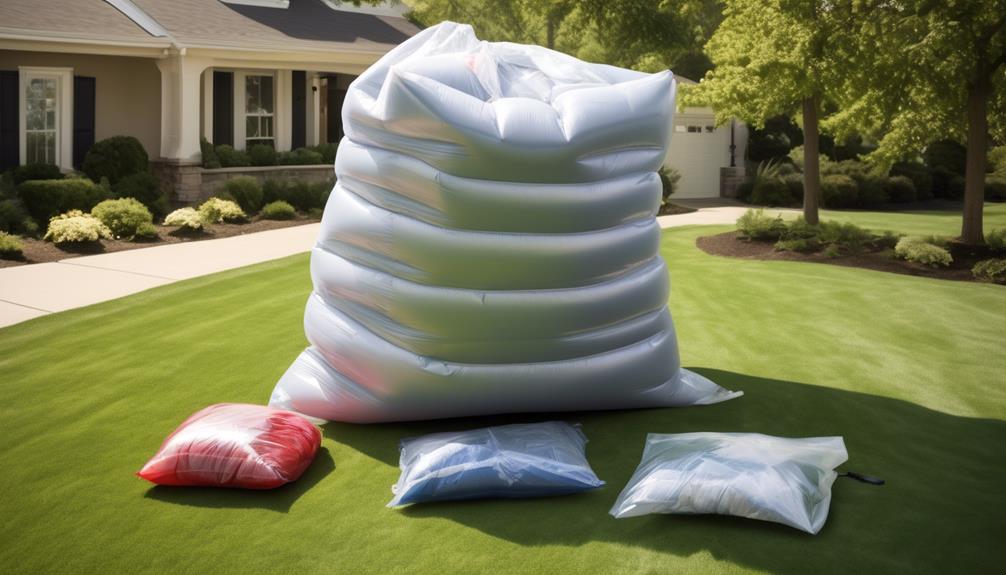
We've found that using vacuum storage bags for inflatable lawn decorations can be incredibly beneficial. Properly sealing the bags is crucial to maintaining the decorations' shape and preventing any air leaks.
Additionally, the space-saving advantages of vacuum storage bags make them an ideal choice for keeping inflatable lawn decorations in top condition.
Vacuum Storage Benefits
Consider using vacuum storage bags as they provide an efficient and space-saving solution for storing inflatable lawn decorations. The benefits of vacuum storage for your inflatable lawn decorations are numerous and include convenience, space saving, organization, and protection. Here's why vacuum storage bags are a great option for your inflatable lawn decorations:
- Space saving: Vacuum storage bags compress your decorations, making them easier to store in closets, attics, or garages.
- Organization: By using vacuum storage bags, you can keep your inflatable lawn decorations neatly organized and free from dust, dirt, and moisture.
- Protection: These bags provide a protective barrier against pests, mildew, and odors, keeping your decorations in top condition for the next use.
- Easy to use: Vacuum storage bags are simple to use and require minimal effort, making the storage process hassle-free.
Proper Sealing Techniques
Using vacuum storage bags for inflatable lawn decorations ensures proper sealing to protect them from damage and maintain their quality between uses. When sealing your inflatables, make sure to follow the manufacturer's recommendations for the best results.
It's important to carefully squeeze out as much air as possible before sealing the bags to ensure a tight seal. Additionally, consider using a vacuum sealer to remove excess air and create a secure seal. This will help prevent any air from leaking back into the bag over time.
When it comes to maintenance, periodically check the seals to ensure they're intact, and reseal the bags if necessary. Proper sealing methods are crucial for keeping your inflatable lawn decorations in top condition for years to come.
Space-Saving Advantages
To maximize storage space and protect inflatable lawn decorations, vacuum storage bags offer a practical solution for ensuring a tight seal and preventing air leakage. By utilizing these space-saving solutions, you can keep your lawn decorations safe and ready for the next use.
Here are some maintenance tips and inflation care for using vacuum storage bags effectively:
- Press Out Air: Before sealing the bag, press out as much air as possible to ensure a compact and space-saving result.
- Seal Properly: Ensure the vacuum storage bag is tightly sealed to prevent any air from re-entering and causing inflation.
- Store Vertically: Store the vacuum-sealed decorations vertically to maximize floor space and prevent damage.
- Check Regularly: Periodically check the bags for any signs of air leakage and reinflate if necessary.
Use a Dedicated Storage Area
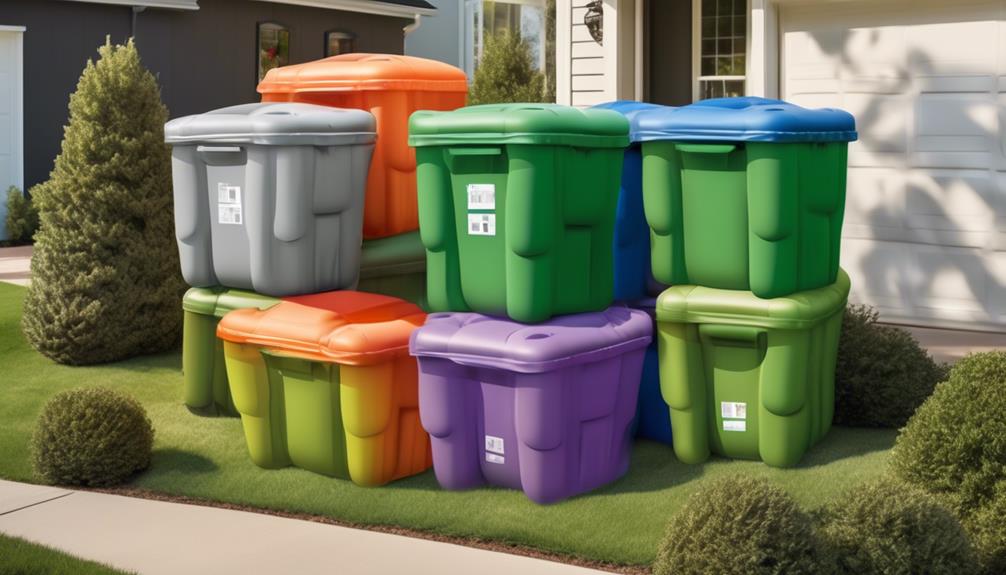
We always store our inflatable lawn decorations in a dedicated storage area to ensure they stay in good condition for the next use. Proper inflation is crucial before storage. We make sure to deflate the decorations properly, as overinflating or underinflating can cause damage.
After deflation, we clean them thoroughly to remove any dirt or debris, ensuring they're completely dry before storing them. This helps to prevent mold or mildew from forming during storage, which could ruin the decorations.
Storage maintenance is also important. We store our inflatables in a cool, dry place away from direct sunlight to prevent fading or damage to the material. It's essential to avoid folding or creasing the decorations, as this could lead to permanent wrinkles or weak spots.
Instead, we carefully roll them up and store them in a sturdy container to protect them from dust and pests. By following these practices, we ensure that our inflatable lawn decorations remain in top condition, ready to bring joy to our outdoor space whenever we choose to use them again.
Protect From Extreme Temperatures
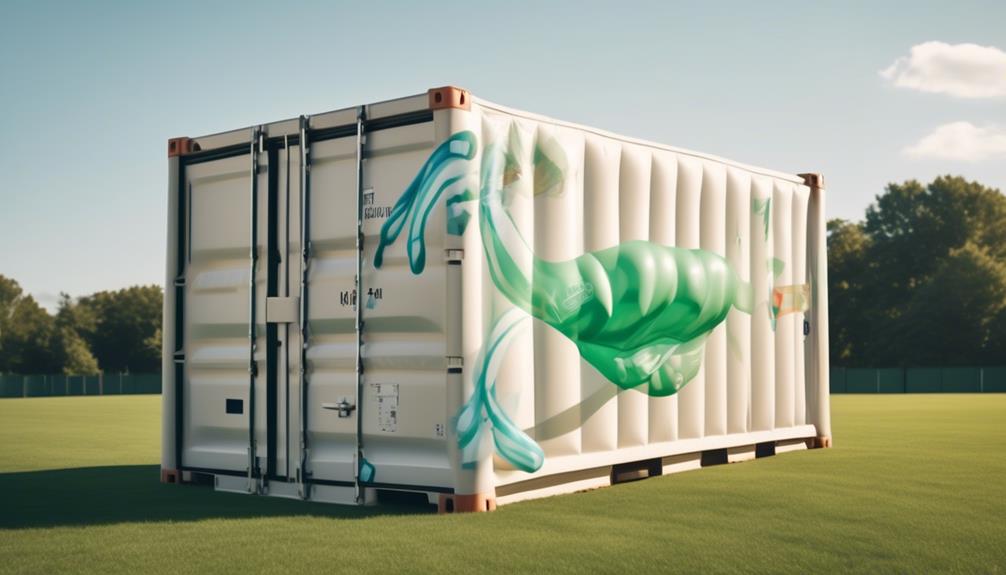
After ensuring our inflatable lawn decorations are stored in a dedicated area and maintained properly, it's crucial to protect them from extreme temperatures to prolong their lifespan and quality. Here are some tips to shield your decorations from the elements:
- Use Protective Covers: Invest in durable, weather-resistant covers designed specifically for inflatable decorations. These covers act as a barrier against harsh sunlight, heavy rain, and snow, preventing damage caused by prolonged exposure to these elements.
- Insulation Techniques: Consider utilizing insulation techniques such as wrapping the inflatable decorations with blankets or bubble wrap before covering them with the protective covers. This extra layer provides insulation against extreme temperatures, helping to regulate the internal temperature and prevent cracking or warping due to excessive heat or cold.
- Avoid Direct Sunlight: Whenever possible, store the inflatable decorations in shaded areas to minimize their exposure to direct sunlight. Prolonged sunlight exposure can cause colors to fade and materials to deteriorate over time.
- Monitor Storage Conditions: Regularly check the storage area to ensure it maintains a stable temperature. Extreme fluctuations in temperature can be detrimental to the longevity of inflatable decorations, so it's essential to keep an eye on the storage environment.
Store in Airtight Containers

We always store our inflatable lawn decorations in airtight containers to prevent any damage.
It's important to ensure that the decorations are properly folded for storage in these containers. This will help protect them from any potential moisture damage.
Airtight Containers Prevent Damage
Storing inflatable lawn decorations in airtight containers helps prevent damage and prolongs their lifespan. Airtight containers provide a protective barrier against potential punctures and moisture, preserving the integrity of the decorations. Here's why airtight containers are essential for safeguarding your inflatable lawn decor:
- Puncture Prevention: Airtight containers shield the decorations from sharp objects, reducing the risk of accidental punctures.
- Moisture Protection: By sealing out moisture, airtight containers prevent mold and mildew growth, keeping your decorations in pristine condition.
- UV Resistance: Certain airtight containers offer UV resistance, protecting the inflatables from sun damage and color fading.
- Space Efficiency: Airtight containers come in various sizes, maximizing storage space and keeping your decorations neatly organized.
Ensuring your inflatable lawn decorations are stored in airtight containers is a simple yet effective way to maintain their quality for years to come.
Properly Folded for Storage
When properly folded for storage, inflatable lawn decorations should be placed in airtight containers to protect them from damage and preserve their quality. Proper folding techniques are essential to ensure that the decorations fit neatly into the storage containers, preventing unnecessary creasing or stress on the material. Here's a simple guide for properly folding inflatable lawn decorations:
| Step | Folding Technique |
|---|---|
| 1 | Deflate completely |
| 2 | Smooth out wrinkles |
| 3 | Fold in half lengthwise |
| 4 | Fold in half widthwise |
| 5 | Roll tightly and secure with straps or ties |
Following these proper storage methods will help maintain the integrity of the decorations, ensuring they stay in top condition for future use. Properly folded and stored decorations also make it easier to set up and enjoy them for years to come.
Protect From Moisture Damage
To protect inflatable lawn decorations from moisture damage, it's essential to store them in airtight containers. Here are some tips to ensure they stay mold-free and in excellent condition:
- Choose the Right Container: Opt for sturdy plastic containers with airtight seals to prevent any moisture from seeping in.
- Proper Ventilation: Before sealing the containers, ensure the decorations are completely dry to prevent mold growth.
- Silica Gel Packs: Place silica gel packs inside the containers to absorb any excess moisture and maintain a dry environment.
- Regular Check-ups: Periodically inspect the containers for any signs of moisture or mold, and ensure proper ventilation to keep the decorations in pristine condition.
Utilize Hanging Storage Solutions

Consider hanging storage solutions to keep your inflatable lawn decorations organized and protected. When it comes to maximizing space, creative hanging options can be a game-changer. You can use sturdy hooks or pegboards in your storage area to hang your inflatable lawn decorations. This not only keeps them off the ground, preventing potential damage, but also frees up valuable floor space for other items. Additionally, utilizing hanging storage solutions can make it easier to access and rotate your decorations throughout the seasons.
We've found that using clear plastic bins with handles can also be a great way to store your deflated inflatables. You can then hang these bins from a ceiling-mounted rack or on wall-mounted hooks, keeping them out of the way until the next holiday season. This method not only protects your decorations from moisture and pests, but also makes it convenient to see what's inside each bin without having to open them.
Consider a Storage Shed

After utilizing hanging storage solutions for our inflatable lawn decorations, we found that investing in a storage shed provided even greater protection and convenience. When it comes to storing inflatable lawn decorations, a storage shed offers several advantages:
- Storage Shed Organization: A dedicated storage shed allows for better organization of decorations. With shelves, hooks, and designated areas, it's easier to keep everything tidy and accessible.
- Weatherproofing Decorations: A storage shed provides a more secure and weatherproof environment for your decorations. It shields them from harsh sunlight, rain, and snow, helping to extend their lifespan.
- Space for Larger Decorations: Unlike hanging solutions, a storage shed can accommodate larger decorations without the risk of them getting tangled or damaged.
- Convenience: Having a storage shed on your property means you can quickly access and put away your decorations without the hassle of setting up and taking down hanging systems.
Organize by Holiday or Theme
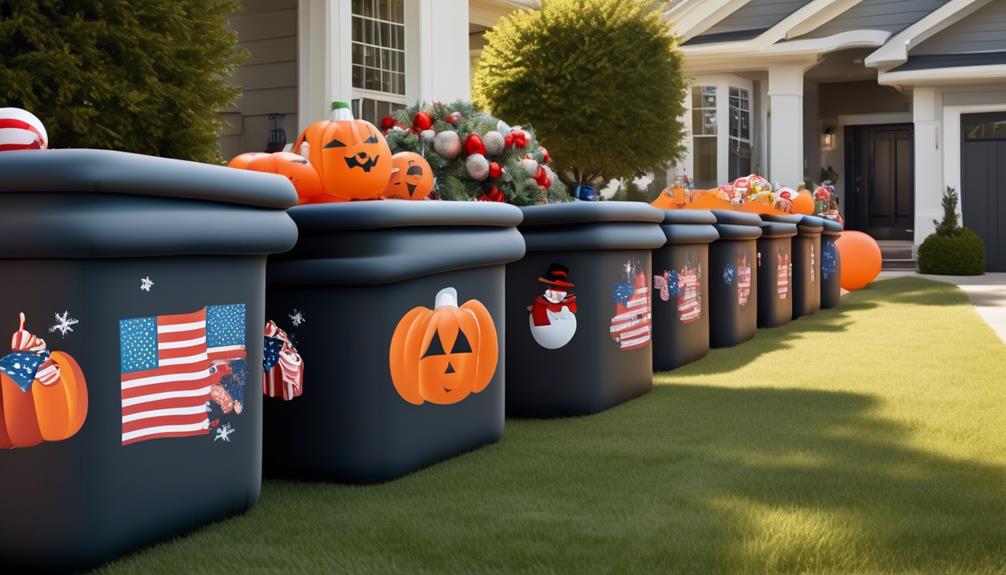
We find that organizing inflatable lawn decorations by holiday or theme enhances the overall aesthetic and makes it easier to rotate and display them throughout the year. By grouping our decorations based on holidays or specific themes, we can quickly locate and set up the ones that are relevant for each season or occasion. Here's a simple table to illustrate how we organize our inflatable lawn decorations by holiday or theme:
| Holiday/Theme | Examples | Storage Box Label |
|---|---|---|
| Halloween | Inflatable ghost, pumpkin | Halloween |
| Christmas | Santa Claus, snowman | Winter Wonderland |
| Patriotic | Uncle Sam, American flag | 4th of July |
| Birthday Party | Birthday cake, balloons | Celebrate |
This method not only keeps our storage area tidy but also brings an element of excitement when unpacking and setting up decorations for each holiday or theme. It makes seasonal rotation and themed displays effortless, allowing us to create an inviting and festive atmosphere throughout the year.
Regularly Inspect for Damage
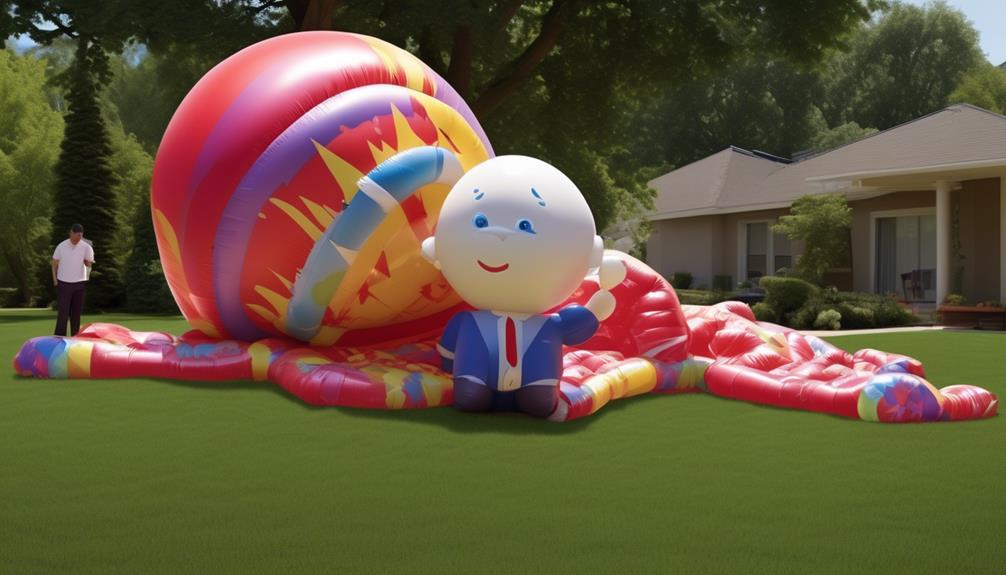
We always make it a point to regularly inspect our inflatable lawn decorations for any signs of damage.
By checking for tears, holes, or punctures, we can catch any issues early on and repair them if necessary.
This ensures that our decorations stay in good condition and are ready to use for the next holiday season.
Check for Damage
Regularly inspect your inflatable lawn decorations for any signs of damage, such as tears, holes, or leaks, to ensure they remain in good condition.
Here are some important steps to take when checking for damage:
- Visual Inspection: Carefully examine the entire surface of the inflatable for tears, holes, or any signs of wear and tear.
- Pressure Test: Inflate the decoration and check for leaks by listening for any hissing sounds or feeling for escaping air.
- Patch if Necessary: If you spot any damage, promptly patch it up using a repair kit to prevent it from worsening.
- Store Properly: After checking for damage, ensure you store the decorations properly to avoid further harm.
Regularly inspecting and maintaining your inflatable lawn decorations will help prolong their lifespan and keep them looking great for many seasons to come.
Repair if Necessary
After checking for any damage such as tears, holes, or leaks, it is important to promptly repair any issues found to maintain the good condition of your inflatable lawn decorations. Regularly inspecting for damage can help you catch and address any issues before they worsen. Here are some repair options and time-saving tips for maintaining your inflatable lawn decorations:
| Repair Options | Time Saving Tips | Materials Needed |
|---|---|---|
| Patching tears with clear adhesive tape | Keep a repair kit handy | Clear adhesive tape, patching material |
| Using a vinyl repair kit for larger holes | Store repair materials with decorations | Vinyl repair kit, patching material |
| Applying sealant to fix leaks | Address issues promptly | Sealant, patching material |
Taking the time to repair any damage promptly will extend the lifespan of your inflatable lawn decorations, saving you time and money in the long run.
Frequently Asked Questions
How Do I Prevent Mold and Mildew From Forming on My Inflatable Lawn Decorations While in Storage?
To prevent moisture damage and mold on inflatable lawn decorations while in storage, we use proper storage techniques.
After cleaning and fully drying the decorations, we fold and store them in a cool, dry place.
Adding some silica gel packets or a dehumidifier can also help absorb excess moisture.
Regularly checking the storage area and ensuring good airflow can further prevent mold and mildew from forming.
Can I Store My Inflatable Lawn Decorations Outdoors in a Covered Area, or Do They Need to Be Stored Indoors?
We can store our inflatable lawn decorations outdoors in a covered area, but it's important to ensure they've weather protection. This will help maintain their durability and prevent damage from the elements.
When considering outdoor storage, it's crucial to prioritize proper coverage and protection to extend the life of the decorations. Regular maintenance and care can also contribute to their longevity when stored outside.
Are There Any Special Precautions I Should Take When Storing Inflatable Decorations With Delicate or Intricate Designs?
When it comes to storing inflatable decorations with delicate or intricate designs, it's crucial to prioritize material care and temperature control.
We've found that carefully folding and storing them in a cool, dry place can help preserve their intricate details. Avoiding exposure to extreme temperatures and moisture is key for maintaining the quality of these decorations.
It's all about showing them a little extra love to keep them looking their best year after year.
What Is the Best Way to Store Inflatable Lawn Decorations That Are Especially Large or Oddly Shaped?
When it comes to storing those extra-large or oddly shaped inflatable lawn decorations, we've found that using a spacious, weatherproof container is key. This helps protect them from the elements and ensures they stay inflated.
Additionally, carefully folding or rolling the decorations can help prevent tears. We've also had success using repair kits for any unexpected damage.
It's all about keeping our beloved lawn decor safe and ready to shine again next season!
Should I Take Any Specific Steps to Protect My Inflatable Decorations From Pests While They Are in Storage?
To prevent pests from ruining our inflatable decorations, we take several precautions.
Firstly, we store them in a clean, dry location.
Secondly, we take extra care to ensure that there are no openings or tears that could allow pests to get inside.
Additionally, we use sealed containers or plastic bags to provide an extra layer of protection.
Lastly, we regularly check the storage area and decorations for any signs of pests to catch and address any issues early.
Conclusion
In conclusion, storing inflatable lawn decorations properly is essential to ensure they stay in good condition for future use.
Did you know that the average inflatable decoration can last for 5-10 years with proper storage and maintenance?
By following these simple steps, you can keep your decorations looking great and ready to use for many seasons to come.
Happy decorating!
- About the Author
- Latest Posts
Introducing Ron, the home decor aficionado at ByRetreat, whose passion for creating beautiful and inviting spaces is at the heart of his work. With his deep knowledge of home decor and his innate sense of style, Ron brings a wealth of expertise and a keen eye for detail to the ByRetreat team.
Ron’s love for home decor goes beyond aesthetics; he understands that our surroundings play a significant role in our overall well-being and productivity. With this in mind, Ron is dedicated to transforming remote workspaces into havens of comfort, functionality, and beauty.
Mardi Gras Decoration
What Was the Original Purpose of Mardi Gras?

We have all witnessed the colorful parades, extravagant costumes, and energetic festivities that are connected with Mardi Gras.
But have you ever wondered about the origins of this exuberant festival?
The original purpose of Mardi Gras dates back to ancient pagan traditions, and its evolution over time is a testament to the intersection of various cultural and religious influences.
Exploring the roots of this festive occasion provides a fascinating glimpse into the rich tapestry of human history and the ways in which traditions can endure and adapt.
Key Takeaways
- Mardi Gras originated from ancient pagan traditions and was influenced by Christian observances.
- It was brought to the New World by French explorers and became an important cultural event in New Orleans.
- Mardi Gras showcases a fusion of European and Creole styles in costumes and a blend of French and Spanish flavors in culinary traditions.
- Modern Mardi Gras celebrations embrace diverse cultural influences, involve community engagement, and serve as a platform for social and political commentary.
Ancient Pagan Celebrations
Ancient pagan celebrations formed the foundation of the original purpose of Mardi Gras, serving as vibrant and ritualistic events deeply intertwined with the cycle of nature and the observance of seasonal changes. These pagan rituals were deeply rooted in ancient traditions, where communities gathered to honor deities, fertility, and the arrival of spring. The festivities were marked by colorful processions, music, dance, and feasting, reflecting a deep connection to the natural world and the spiritual beliefs of the time.
Pagan rituals during Mardi Gras were often linked to agricultural practices, signifying the transition from winter to spring and the renewal of life. The celebrations were a way for people to express gratitude for the earth's bounty and seek blessings for the upcoming planting season. These ancient traditions also included symbolic acts of purification and the casting away of winter's hardships, paving the way for new beginnings.
Understanding the origins of Mardi Gras in ancient pagan celebrations provides a rich historical context for the modern-day festivities. It highlights the enduring human connection to nature, spirituality, and communal celebration, offering a glimpse into the deep-seated traditions that continue to influence this vibrant event.
Christian Observances
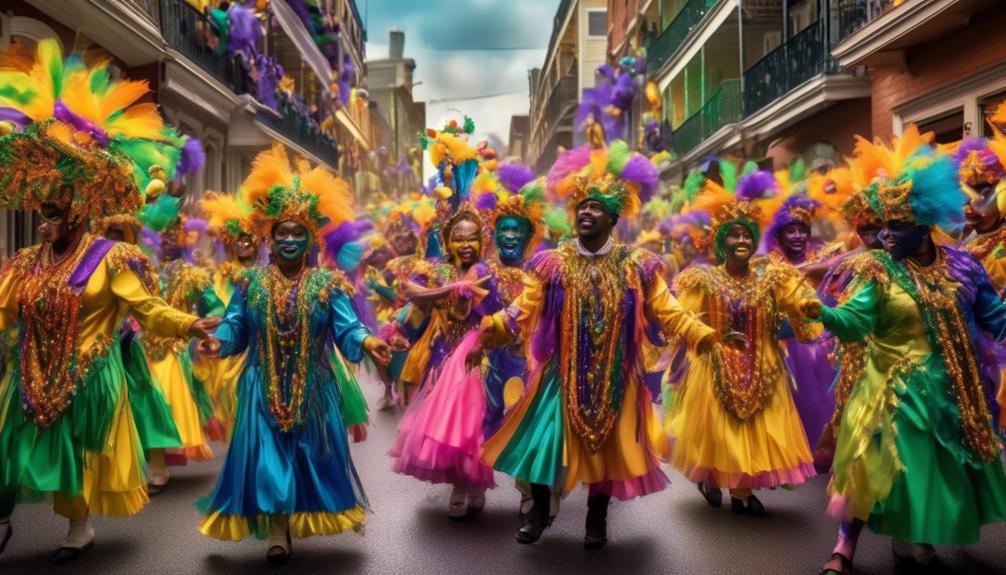
The influence of Christian observances on Mardi Gras is evident in the evolution of the festival's traditions and practices, revealing a dynamic interplay between ancient pagan rituals and Christian religious significance. Mardi Gras, also known as Fat Tuesday, is the culmination of the Carnival season and is followed by Ash Wednesday, which marks the beginning of Lent. The festival serves as a time of revelry and indulgence before the solemn period of Lenten observances in the Christian calendar. This juxtaposition of celebration and penance reflects the duality of human nature and the Christian belief in redemption and forgiveness.
| Christian Symbolism | Lenten Observances |
|---|---|
| Purple: Represents justice, penance, and humility | Fasting: A practice of self-discipline and self-reflection |
| Gold: Symbolizes power and glory of Christ | Prayer: A means of seeking spiritual growth and connection |
| Green: Signifies faith, hope, and eternal life | Almsgiving: Demonstrating compassion and generosity towards others |
| Ashes: Symbol of mortality and repentance | Abstinence: Voluntary renunciation of certain pleasures for spiritual discipline |
Christian symbolism is deeply woven into the fabric of Mardi Gras, enriching the festival with layers of spiritual meaning and cultural significance. The observance of Lent, with its emphasis on self-discipline and spiritual reflection, provides a poignant contrast to the exuberant festivities of Mardi Gras, embodying the fundamental Christian values of repentance, renewal, and grace.
Pre-Lenten Festivities
Preceding the onset of Lent, the pre-Lenten festivities of Mardi Gras are characterized by vibrant parades, elaborate masquerade balls, and exuberant street celebrations. These pre-Lenten revelries have their roots in ancient traditions that date back thousands of years.
In many cultures, these festivities marked the transition from winter to spring and were often associated with fertility rites and the honoring of deities. The ancient Romans had a similar festival called Lupercalia, which involved processions, feasting, and masquerade. As Christianity spread and adapted to local customs, these ancient traditions became intertwined with the Christian observance of Lent.
The modern Mardi Gras celebrations continue to embody elements of these ancient traditions, combining them with the Christian practice of preparing for the Lenten season. This fusion of cultural and religious influences has shaped the pre-Lenten revelry into the vibrant and diverse event it's today.
Spring Equinox Rituals
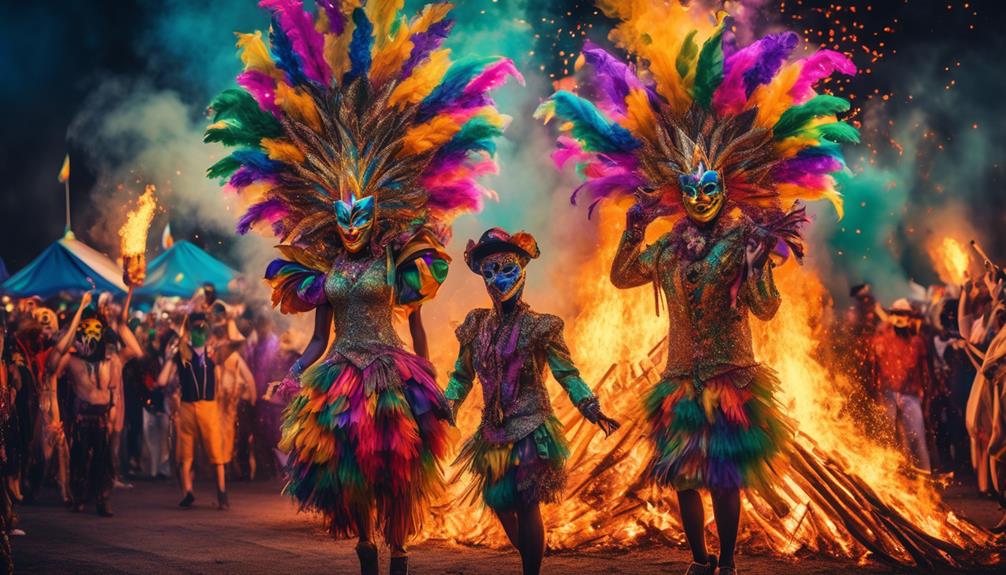
Spring equinox rituals mark an important shift in seasonal celebrations, embodying cultural and religious influences that have evolved over time, including the vibrant traditions of Mardi Gras. The symbolism of the spring equinox is deeply rooted in ancient fertility rituals and the celebration of new life. Across various cultures, the equinox represents a time of balance and renewal, as the earth awakens from winter's slumber. The concept of fertility is central to many spring equinox traditions, symbolizing the regenerative power of nature and the potential for growth and abundance.
In many ancient societies, the spring equinox was a time for elaborate fertility rites, often involving dances, processions, and offerings to deities associated with fertility and agriculture. These rituals were performed to ensure a bountiful harvest and the continued fertility of the land.
In the context of Mardi Gras, the spring equinox serves as a backdrop for the revelry and exuberant festivities that precede the solemnity of Lent. The themes of rebirth, fertility, and abundance are interwoven into the vibrant tapestry of Mardi Gras, reflecting the enduring influence of spring equinox symbolism on cultural traditions.
Feast of Lupercalia
The Feast of Lupercalia, an ancient Roman festival, was a significant event that included pagan fertility rituals and purification ceremonies.
This festival was dedicated to the Roman god of agriculture and fertility, Lupercus, and the Roman founders Romulus and Remus.
The celebration involved various rites aimed at promoting fertility, ensuring health, and warding off evil spirits.
Pagan Fertility Rituals
Rooted in ancient Roman tradition, the Feast of Lupercalia was a pagan fertility ritual that took place annually on February 15th.
This ancient festival was steeped in fertility symbolism and was dedicated to the Roman god of agriculture and fertility, Faunus, as well as the founders of Rome, Romulus and Remus.
The rituals of Lupercalia involved the sacrifice of goats and dogs, and the subsequent whipping of women and crops with the animals' hides. These practices were believed to promote fertility and purification.
The festival also included matchmaking and fertility rites, emphasizing the renewal of life and the coming of spring.
The Feast of Lupercalia was a significant event in ancient Rome, reflecting the importance placed on fertility and the cycles of nature in ancient rituals.
Roman Purification Ceremonies
Pagan fertility rituals, such as the Feast of Lupercalia, were rooted in ancient Roman tradition and included purification ceremonies aimed at promoting fertility and renewal. These Roman rituals were an integral part of ancient traditions, symbolizing the transition from winter to spring.
The Feast of Lupercalia, celebrated from February 13 to 15, involved various purification rites to cleanse and renew the city. Participants would gather at the sacred cave where the infants Romulus and Remus were believed to have been cared for by the she-wolf, and priests would sacrifice goats and a dog. Following this, the priests would smear the foreheads of the participants with the sacrificial blood, symbolizing purification and fertility.
These ancient traditions were deeply ingrained in Roman culture and played a significant role in promoting the continuity of life through these fertility rituals.
New Orleans Influence
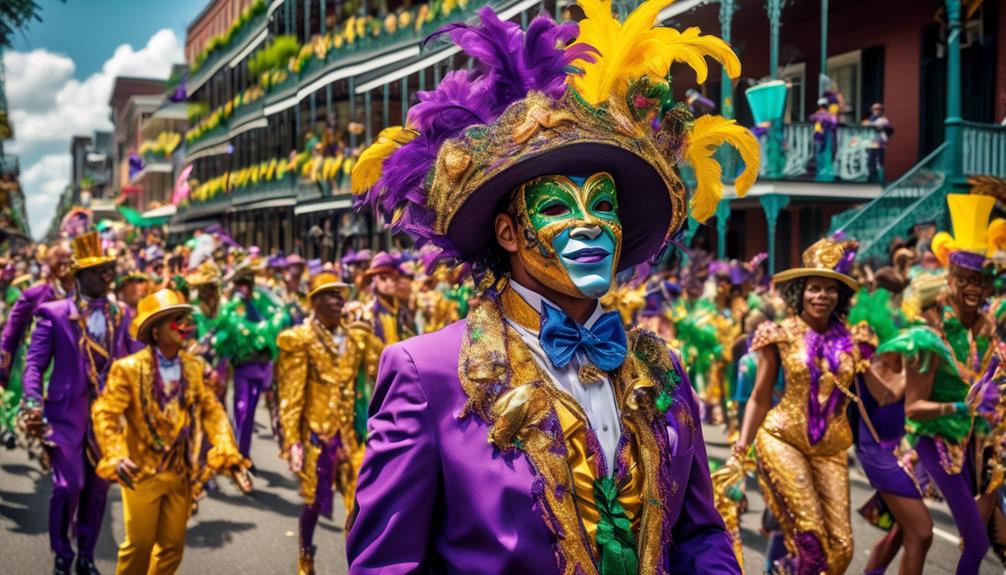
Influenced by the diverse cultural heritage and historical events of New Orleans, Mardi Gras has evolved into a vibrant and eclectic celebration that has left a lasting impact on the city's identity. The New Orleans culture and historical significance have shaped Mardi Gras into a unique and enduring tradition.
Here are four key ways in which New Orleans has influenced the evolution of Mardi Gras:
- French and Spanish Influence: New Orleans' rich French and Spanish colonial history has infused Mardi Gras with a European flair, seen in the elegant masquerade balls and elaborate costumes.
- African-American Heritage: The city's strong African-American influence has brought soulful music, lively dance, and vibrant parade traditions to Mardi Gras, making it a celebration of diversity and cultural fusion.
- Creole Traditions: The Creole community's customs and cuisine have contributed to the festive atmosphere of Mardi Gras, with delectable culinary delights and lively street parties.
- Social and Political Impact: Mardi Gras has been a platform for social and political expression, reflecting the city's tumultuous history and ongoing struggles, making it a dynamic and evolving cultural phenomenon.
Social and Cultural Gatherings

Mardi Gras has long been a time for festive community celebrations, bringing people together to participate in cultural traditions and customs.
These gatherings provide an opportunity for social interaction and the sharing of unique cultural experiences.
The rich history and diverse cultural influences of Mardi Gras make it a significant event for fostering community bonds and preserving heritage.
Festive Community Celebrations
The festive community celebrations, rooted in rich social and cultural traditions, serve as a unifying force and a testament to the collective spirit of the community. These gatherings encompass a deep sense of community involvement, bringing people together and fostering a sense of unity and belonging.
They provide a platform for neighborhood festivities, allowing individuals to come together and celebrate their shared heritage and values. Through these events, cultural and social identities are reaffirmed, strengthening the bonds within the community.
The festive community celebrations also offer an opportunity for intergenerational connections, as traditions are passed down and shared amongst community members, ensuring their preservation for future generations. This collective celebration not only promotes a sense of togetherness but also serves as a means of preserving and honoring cultural heritage.
Cultural Traditions and Customs
Rooted in the rich tapestry of cultural traditions and customs, the social and cultural gatherings of Mardi Gras serve as a vibrant reflection of community identity and heritage.
Mardi Gras is steeped in customary celebrations and traditional rituals that have been passed down through generations, embodying the values and beliefs of the communities that celebrate it.
These festivities aren't merely about revelry; they're a living expression of the collective history and spirit of the people. The colorful parades, elaborate costumes, and lively music all play a pivotal role in connecting individuals to their cultural roots, fostering a sense of belonging and unity.
Through these time-honored practices, Mardi Gras continues to be a symbol of resilience and cultural pride, showcasing the enduring legacy of tradition in shaping the social fabric of communities.
Lenten Preparation Traditions
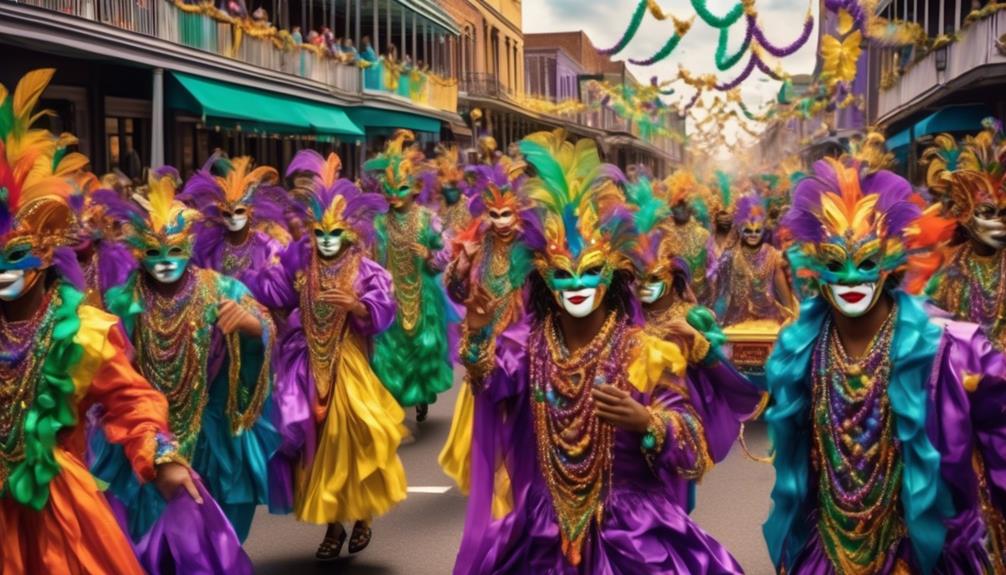
During the period leading up to Lent, various traditional practices and rituals are observed as part of the preparation for the solemnity of the Lenten season. These traditions are deeply rooted in religious and cultural significance and play a vital role in the spiritual preparation for the upcoming season.
- Lenten Fasting: One of the central aspects of Lenten preparation is fasting. This practice involves abstaining from certain foods or meals as a way of disciplining the body and focusing on spiritual renewal.
- Prayer and Reflection: Many individuals engage in increased prayer and reflection during the period leading up to Lent. This serves as a time for introspection, seeking forgiveness, and deepening one's spiritual connection.
- Almsgiving: Giving to those in need is another important tradition associated with Lenten preparation. This act of charity and generosity is viewed as a way to embody the spirit of compassion and selflessness.
- Attending Religious Services: As Lent draws near, attending religious services becomes more frequent. This includes participating in special Masses, liturgies, and devotional practices to spiritually prepare for the season.
These Lenten preparation traditions serve as a meaningful way for individuals and communities to engage in a period of self-examination, spiritual growth, and preparation for the observance of Lent.
Religious Symbolism

Engaging in religious symbolism during the period leading up to Lent serves as a profound means of expressing and reinforcing spiritual beliefs and values.
The religious symbolism of Mardi Gras has deep historical significance, rooted in the traditions of various cultures. The use of colors, such as purple to signify justice, green for faith, and gold for power, holds great religious symbolism. These colors aren't only visually striking but also carry a rich history of representing values and virtues.
The practice of wearing masks during Mardi Gras is also steeped in religious symbolism. Masks were originally worn to blur social distinctions, allowing people to mix and mingle without regard to their societal status, as a way to embody the Christian virtue of humility.
Additionally, the tradition of consuming rich, fatty foods during Mardi Gras, such as the famous King Cake, is a symbolic way of using up the rich ingredients in the household before the fasting period of Lent begins.
These religious symbols and practices aren't only part of the historical significance of Mardi Gras but also continue to be integral aspects of its modern-day celebrations.
Masked Balls and Masquerades
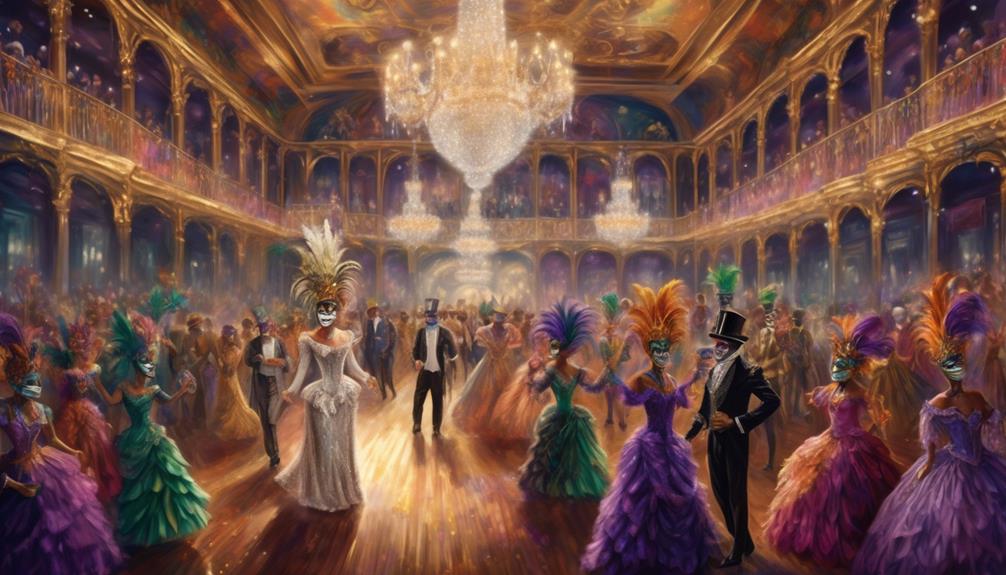
Masked balls and masquerades have been integral elements of Mardi Gras celebrations, embodying the spirit of revelry and anonymity that defines this festive occasion. These events hold historical significance and have evolved to become an essential part of Mardi Gras traditions, serving various purposes throughout history.
- Masquerade Costumes: Participants don elaborate and often extravagant costumes, allowing them to conceal their identities and embrace a sense of freedom and playfulness during the festivities.
- Historical Significance: Masquerade balls were initially introduced as a way for people of different social classes to come together and interact without the constraints of their societal roles, promoting a sense of equality and camaraderie.
- Social Gatherings: These events provide a platform for individuals to engage in social interactions, fostering connections and relationships within the community while engaging in the joyous celebrations of Mardi Gras.
- Religious Observances: In the past, masquerades were also used as a way to blur the lines between the sacred and the profane, allowing people to engage in revelry before the solemn observance of Lent.
Masquerade balls and masquerades continue to play a vital role in Mardi Gras, symbolizing the celebration's historical roots and the spirit of revelry that defines it.
Carnival Season Origins
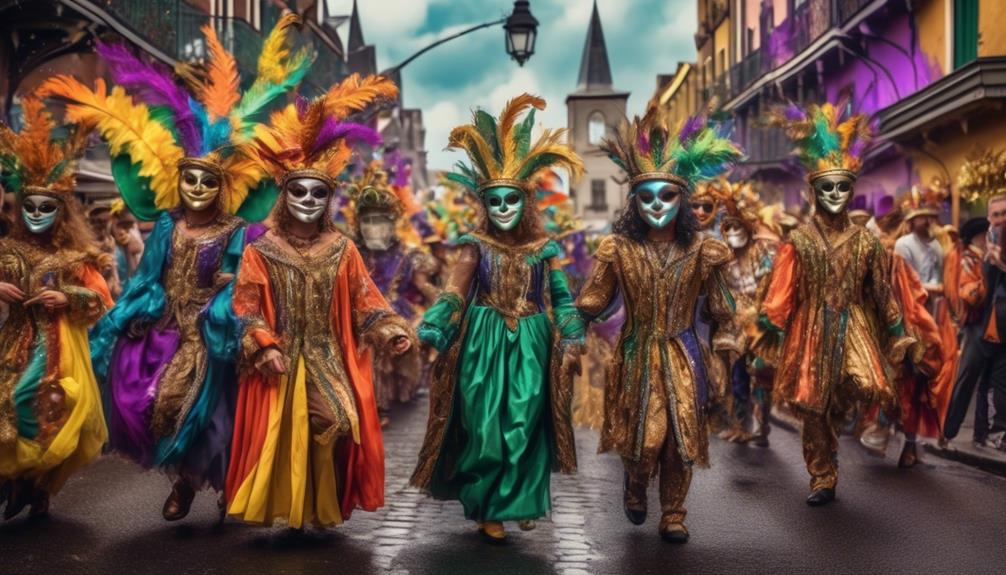
The historical significance of masquerade balls and their role in fostering social interactions during Mardi Gras provides a valuable context for understanding the origins of the Carnival season. The origins of Carnival season can be traced back to ancient pagan spring festivals, such as the Roman Saturnalia and the Greek Dionysian celebrations. These festivities were characterized by feasting, drinking, and role-reversals, where social norms were temporarily inverted. As Christianity spread throughout Europe, these pagan traditions became intertwined with the Christian liturgical calendar, leading to the development of Carnival as a period of revelry and excess before the somber season of Lent.
Historical origins of Carnival season also reflect cross-cultural influences. The tradition of Carnival was brought to the Americas by European colonists, where it melded with indigenous and African traditions. In particular, the African influence can be seen in the vibrant music, dance, and elaborate costumes that are integral to Carnival celebrations in the Caribbean and Latin America.
Understanding the historical origins and cross-cultural influences of Carnival season provides insight into the rich tapestry of traditions that have contributed to the vibrant and diverse celebrations observed around the world today.
French and Spanish Influence

The French and Spanish influence on Mardi Gras is a crucial aspect of its history. We can observe the impact of cultural exchange on the traditions and customs associated with the celebration.
Additionally, the shift in religious significance and the evolution of festive traditions reflect the complex interplay between French and Spanish influences on the development of Mardi Gras.
Cultural Exchange Impact
In the development of Mardi Gras, the cultural exchange impact of French and Spanish influence is evident in the distinctive elements of the celebration, including the music, cuisine, and traditions that have endured through the centuries. This fusion has contributed to the rich tapestry of Mardi Gras, shaping its historical significance and continuing influence on contemporary celebrations.
The cultural exchange impact is demonstrated through:
- Music: The lively rhythms of jazz and zydeco, influenced by African, French, and Spanish musical traditions, create the vibrant soundscape of Mardi Gras.
- Cuisine: The melding of French and Spanish culinary techniques with Creole and Cajun flavors has resulted in the delectable array of dishes synonymous with Mardi Gras, such as gumbo, jambalaya, and king cake.
- Traditions: The masquerade balls, parades, and flamboyant costumes reflect the amalgamation of French and Spanish customs with those of other cultural influences.
- Language: The use of French and Spanish phrases in Mardi Gras festivities underscores the enduring linguistic impact of these cultures.
Religious Significance Shift
French and Spanish influence has significantly shaped the religious significance of Mardi Gras, underscoring the evolution of its cultural and spiritual dimensions over time.
Historical evolution reveals that Mardi Gras originated from ancient Roman pagan celebrations and later evolved into a Christian festival with the arrival of French and Spanish settlers in the Americas. The Spanish introduced the tradition of masked balls, while the French contributed the concept of elegant social gatherings.
These cultural elements intertwined with religious transformation, as Mardi Gras became associated with the Christian calendar, marking the period before the solemnity of Lent. The fusion of French and Spanish customs with Christian rituals resulted in a unique religious significance for Mardi Gras, blending elements of revelry and repentance, festivity and spirituality.
This historical interplay continues to characterize the religious essence of Mardi Gras today.
Festive Traditions Evolution
Drawing from the rich cultural tapestry of French and Spanish influence, Mardi Gras has undergone a vibrant evolution in its festive traditions. This evolution is evident in various aspects of the celebration, including:
- Festive Costumes: The influence of French and Spanish cultures brought an array of colorful and elaborate costumes to Mardi Gras. These costumes reflect a fusion of European and Creole styles, adding a unique flair to the festivities.
- Musical Performances: The musical landscape of Mardi Gras has been shaped by the rhythmic influences of both French and Spanish traditions. This fusion has given rise to vibrant performances, including lively brass bands, rhythmic drumming, and traditional folk music.
- Parade Floats: The elaborate and ornate parade floats seen during Mardi Gras are a testament to the artistic influences of French and Spanish cultures, showcasing intricate designs and vibrant colors.
- Culinary Delights: The culinary traditions of Mardi Gras have been enriched by the fusion of French and Spanish flavors, resulting in a delectable array of dishes that tantalize the taste buds during the festivities.
Evolution of Mardi Gras Parades
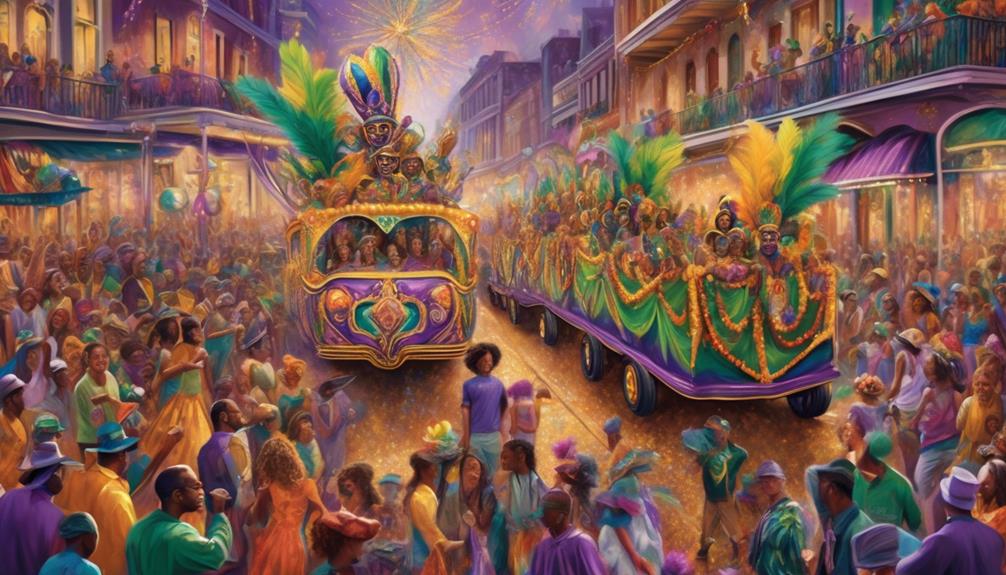
Historically, Mardi Gras parades have evolved from simple processions to elaborate and grand spectacles that showcase the vibrant culture and traditions of the communities that celebrate this festive event. The evolution of Mardi Gras parades can be traced back to the mid-19th century when the first organized parades took place in New Orleans. Initially, these parades featured horse-drawn carriages and pedestrians in masks and costumes, reflecting the modest beginnings of this tradition. Over time, parade floats became an integral part of the Mardi Gras celebrations, with organizations known as 'krewes' constructing elaborate and thematic floats to entertain the crowds.
The evolution of Mardi Gras parades has also been marked by the transformation of costume designs and materials. In the early years, costumes were often handmade and relatively simple, reflecting the resources available to the revelers. Today, costumes have become more intricate and diverse, incorporating a wide range of materials and designs that reflect the creativity and individuality of the participants.
The evolution of parade floats and costumes has contributed to the immersive and visually stunning nature of Mardi Gras parades, making them a hallmark of this beloved tradition.
Contemporary Celebrations
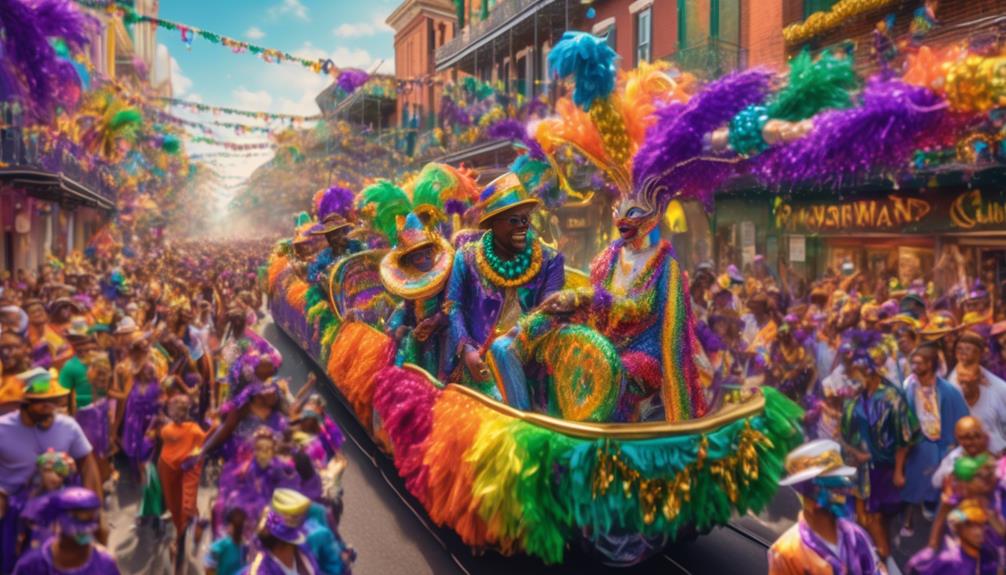
As Mardi Gras parades have evolved into grand spectacles featuring elaborate floats and intricate costumes, contemporary celebrations continue to captivate with their vibrant displays and cultural significance. Modern celebrations of Mardi Gras are a blend of traditional customs and new elements that reflect the evolving cultural landscape of the communities that celebrate it.
Here are key aspects of contemporary Mardi Gras celebrations:
- Diverse Cultural Influences: Modern Mardi Gras celebrations embrace a wide array of cultural influences, incorporating music, dance, and culinary traditions from various ethnic backgrounds.
- Community Engagement: Contemporary Mardi Gras celebrations often focus on community involvement, with local schools, businesses, and organizations participating in parades and hosting events.
- Social Commentary: In today's celebrations, there's a growing trend of using Mardi Gras as a platform for social and political commentary, addressing current issues and advocating for change.
- Technological Integration: With the advent of social media and digital technology, modern Mardi Gras celebrations have integrated these tools to enhance the experience, from live streaming parades to interactive engagement with global audiences.
These modern elements blend seamlessly with the rich historical customs, ensuring that Mardi Gras remains a celebration deeply rooted in tradition while also embracing contemporary expressions of culture and art.
Global Mardi Gras Traditions

As we explore the original purpose of Mardi Gras, it's essential to recognize the diverse Mardi Gras traditions that exist around the world.
From the colorful spectacles of Rio de Janeiro to the lively street parades in New Orleans, Mardi Gras celebrations vary widely across different cultures and regions.
Understanding these cultural Mardi Gras practices allows us to appreciate the global significance and impact of this festive tradition.
Mardi Gras Around World
Throughout the world, Mardi Gras celebrations exhibit a rich tapestry of cultural traditions, each with its own unique blend of customs, rituals, and festivities.
- Brazil: The Brazilian Carnival in Rio de Janeiro is one of the most famous Mardi Gras celebrations, featuring samba parades, colorful costumes, and lively music.
- Italy: In Venice, Mardi Gras, known as Carnevale, is marked by elaborate masquerade balls and grand processions along the city's canals.
- Haiti: Mardi Gras, or Kanaval, in Haiti involves vibrant street parades, traditional Rara music, and intricate papier-mâché masks.
- Germany: Fasching in Germany involves street festivals, costume balls, and the symbolic figure of the 'Fasching Prince' leading the revelries.
These global traditions showcase the diverse ways in which Mardi Gras is celebrated, reflecting the cultural significance and historical influences of each region.
Diverse Mardi Gras Celebrations
Diving into the diverse Mardi Gras celebrations around the world reveals a rich tapestry of cultural traditions, each with its own unique blend of customs, rituals, and festivities.
Modern interpretations of Mardi Gras can be seen in various global celebrations, from the exuberant carnival in Rio de Janeiro, Brazil, to the colorful Carnevale in Venice, Italy.
Regional variations add depth to the celebrations, such as the vibrant Junkanoo festival in the Bahamas, where African rhythms and dance converge with colorful costumes and street parades.
The German Karneval showcases a blend of pagan and Christian traditions, featuring elaborate processions and masked balls.
In the United States, New Orleans' Mardi Gras stands out with its iconic parades, masked balls, and lively street parties, drawing from French, African, and Creole influences.
These diverse celebrations reflect the dynamic evolution of Mardi Gras traditions across the globe.
Cultural Mardi Gras Practices
Cultural Mardi Gras practices across the globe showcase a rich diversity of traditions and festivities, each with its own unique blend of customs and rituals. These celebrations often feature cultural dances and traditional music. Mardi Gras festivities are often accompanied by vibrant cultural dances and traditional music, reflecting the unique heritage of the region.
Costume designs and parade floats are another prominent feature of Mardi Gras celebrations. Elaborate and colorful costume designs are a prominent feature of Mardi Gras celebrations, with intricate details that reflect the cultural symbolism of the community. Additionally, parade floats are meticulously designed to depict historical events, folklore, or contemporary themes, adding a captivating visual element to the festivities.
Community feasts and culinary traditions also play a significant role in Mardi Gras. Mardi Gras is also synonymous with indulgent feasts and culinary traditions, where communities come together to enjoy a rich array of traditional dishes and delicacies.
Cultural rituals and performances are integral to Mardi Gras celebrations. Various cultural rituals and performances are integral to Mardi Gras celebrations, often passed down through generations, contributing to the richness of the cultural tapestry on display.
Frequently Asked Questions
How Did Mardi Gras Spread to Different Countries and Cultures Around the World?
Mardi Gras spread to different countries and cultures through cultural exchange and global influence. The festival's vibrant traditions, like colorful parades and masquerade balls, captivated people worldwide. As the celebration gained popularity, it transcended borders, blending with local customs and evolving into diverse iterations.
Mardi Gras' ability to adapt and inspire reflects its profound impact on global festivities, showcasing the interconnectedness of cultures and the enduring spirit of celebration.
What Are Some Unique Mardi Gras Traditions That Are Specific to Certain Regions or Communities?
Regional customs and community traditions are integral to Mardi Gras, with cultural variations reflecting historical significance.
In specific regions, unique customs like the Courir de Mardi Gras in rural Louisiana or the Zulu coconut throws in New Orleans showcase diverse traditions.
These customs foster a sense of community and pride, highlighting the rich tapestry of Mardi Gras celebrations.
The regional variations add an extra layer of excitement and historical depth to this vibrant festival.
What Is the Significance of the Colors Purple, Green, and Gold in Mardi Gras Celebrations?
The significance of purple, green, and gold in Mardi Gras celebrations lies in their symbolism. These colors have deep-rooted meanings in traditional customs and represent justice, faith, and power.
They're an integral part of the festive atmosphere, adorning everything from costumes to decorations. The use of these vibrant hues adds to the rich tapestry of Mardi Gras, reflecting the historical and cultural significance of this joyous celebration.
How Has Technology and Social Media Impacted the Way Mardi Gras Is Celebrated in Modern Times?
With the rise of technology and social media, Mardi Gras celebrations have transformed, embracing virtual parades and digital marketing strategies.
The impact of social media has led to heightened community engagement, allowing people to participate in virtual celebrations and share the festivities globally.
This shift has expanded the reach of Mardi Gras, creating new opportunities for connection and participation, while also preserving the traditions that make this event so cherished.
Are There Any Environmental or Sustainability Concerns Related to Mardi Gras Celebrations, Such as Parade Waste or Impact on Local Ecosystems?
Parade waste poses a significant concern for sustainability during Mardi Gras. We've noticed the impact on local ecosystems due to litter and pollution. The sheer volume of beads, plastic cups, and other debris can harm wildlife and waterways.
Addressing these issues is crucial for the long-term health of our environment. Our research highlights the need for eco-friendly practices and community involvement to mitigate these environmental impacts and ensure a more sustainable Mardi Gras celebration.
Conclusion
In conclusion, Mardi Gras has evolved from ancient pagan rituals to a global celebration of joy and revelry.
The original purpose of Mardi Gras was rooted in pre-Lenten festivities and spring equinox rituals, but it has since transformed into a colorful and vibrant expression of cultural diversity and community spirit.
As the saying goes, 'Mardi Gras is a melting pot of traditions, a symphony of sights and sounds that stir the soul and ignite the senses.'
- About the Author
- Latest Posts
Introducing Ron, the home decor aficionado at ByRetreat, whose passion for creating beautiful and inviting spaces is at the heart of his work. With his deep knowledge of home decor and his innate sense of style, Ron brings a wealth of expertise and a keen eye for detail to the ByRetreat team.
Ron’s love for home decor goes beyond aesthetics; he understands that our surroundings play a significant role in our overall well-being and productivity. With this in mind, Ron is dedicated to transforming remote workspaces into havens of comfort, functionality, and beauty.
-

 Vetted4 weeks ago
Vetted4 weeks ago15 Best Contact Paper for Kitchen Cabinets to Elevate Your Home Decor
-

 Vetted2 weeks ago
Vetted2 weeks ago15 Best Poe Cameras for Home Security – Reviews & Buying Guide
-

 Vetted3 weeks ago
Vetted3 weeks ago15 Best Drain Snakes to Unclog Your Pipes Like a Pro
-

 Beginners Guides5 days ago
Beginners Guides5 days agoI Inhaled Vinegar Fumes
-

 Vetted4 weeks ago
Vetted4 weeks ago14 Best Stationery Brands for Your Next Writing Adventure
-

 Beginners Guides2 weeks ago
Beginners Guides2 weeks agoSwinger Porch Light Color
-

 Mardi Gras Decoration4 weeks ago
Mardi Gras Decoration4 weeks agoWhy Does Hobby Lobby Not Do Mardi Gras?
-

 Vetted2 weeks ago
Vetted2 weeks ago15 Best Blinds for Bathroom Windows to Enhance Privacy and Style


























